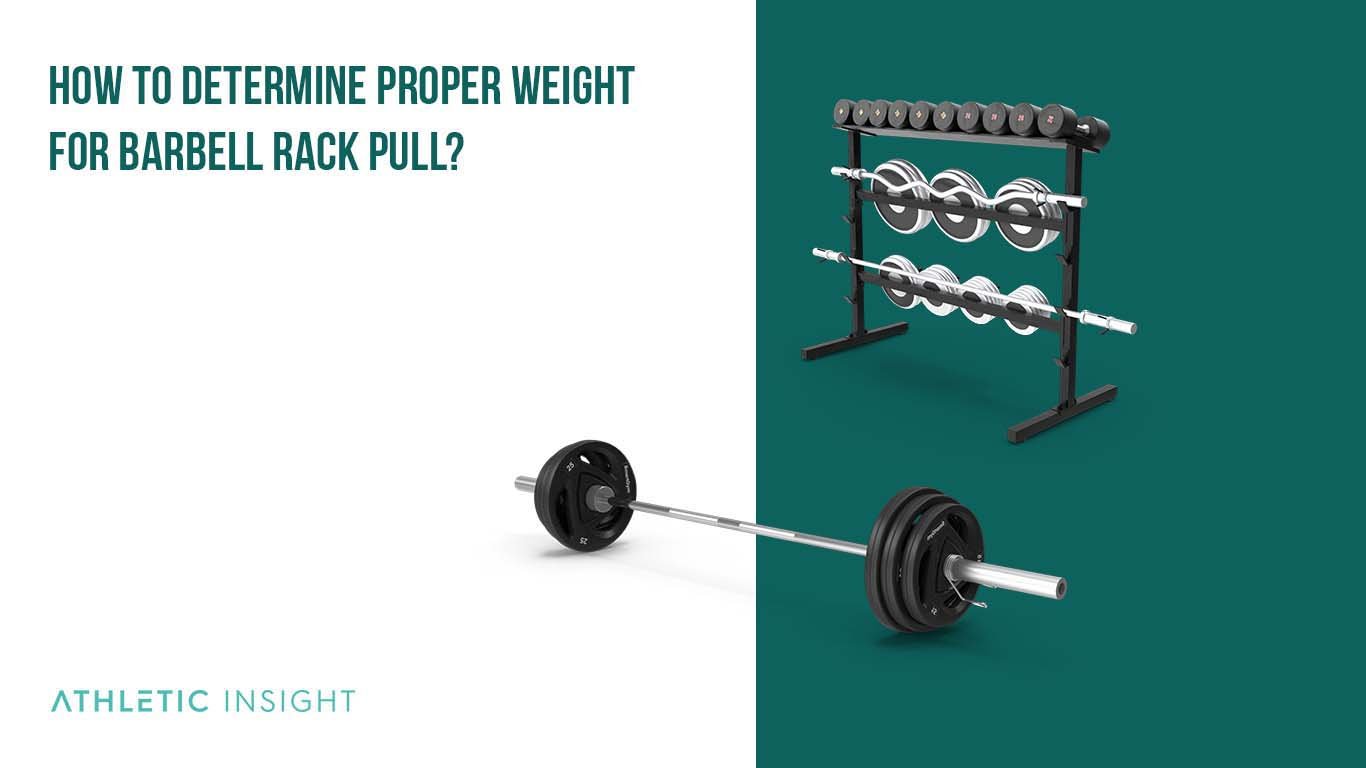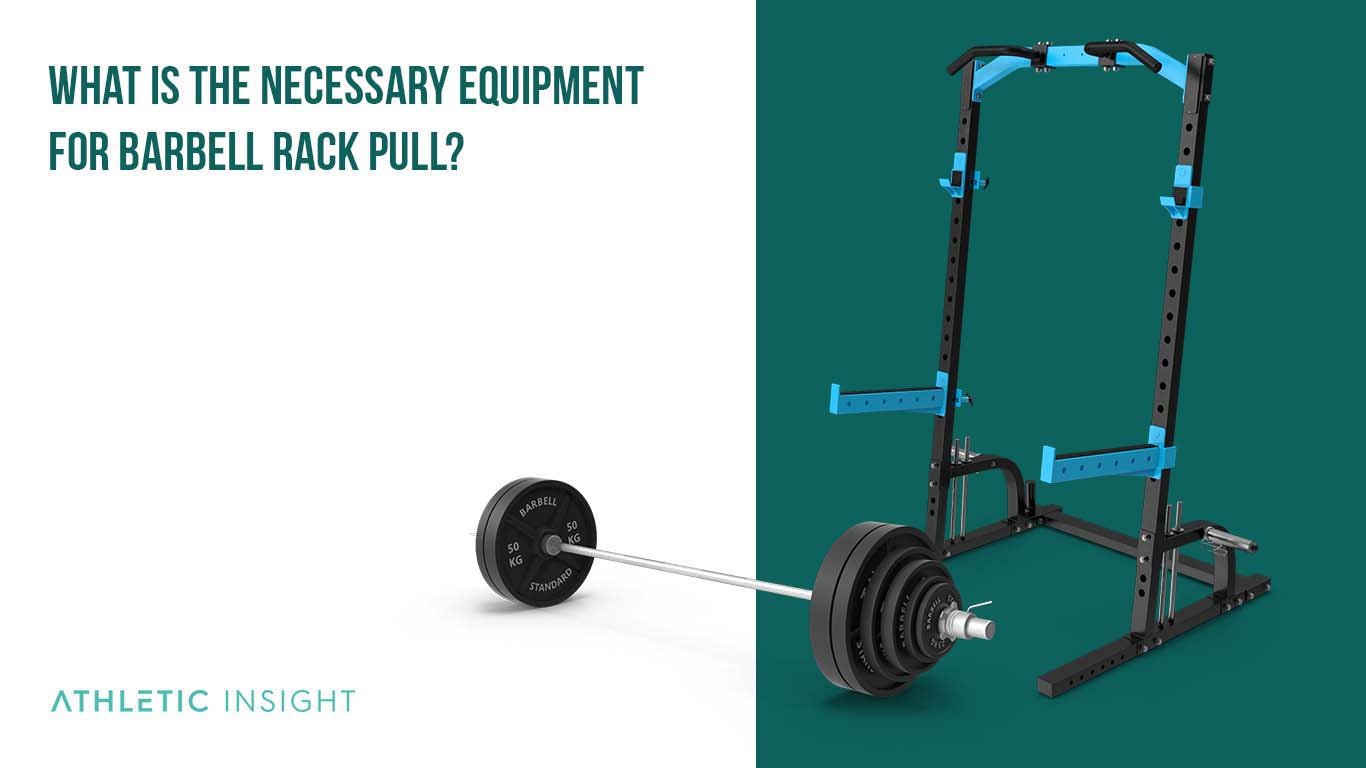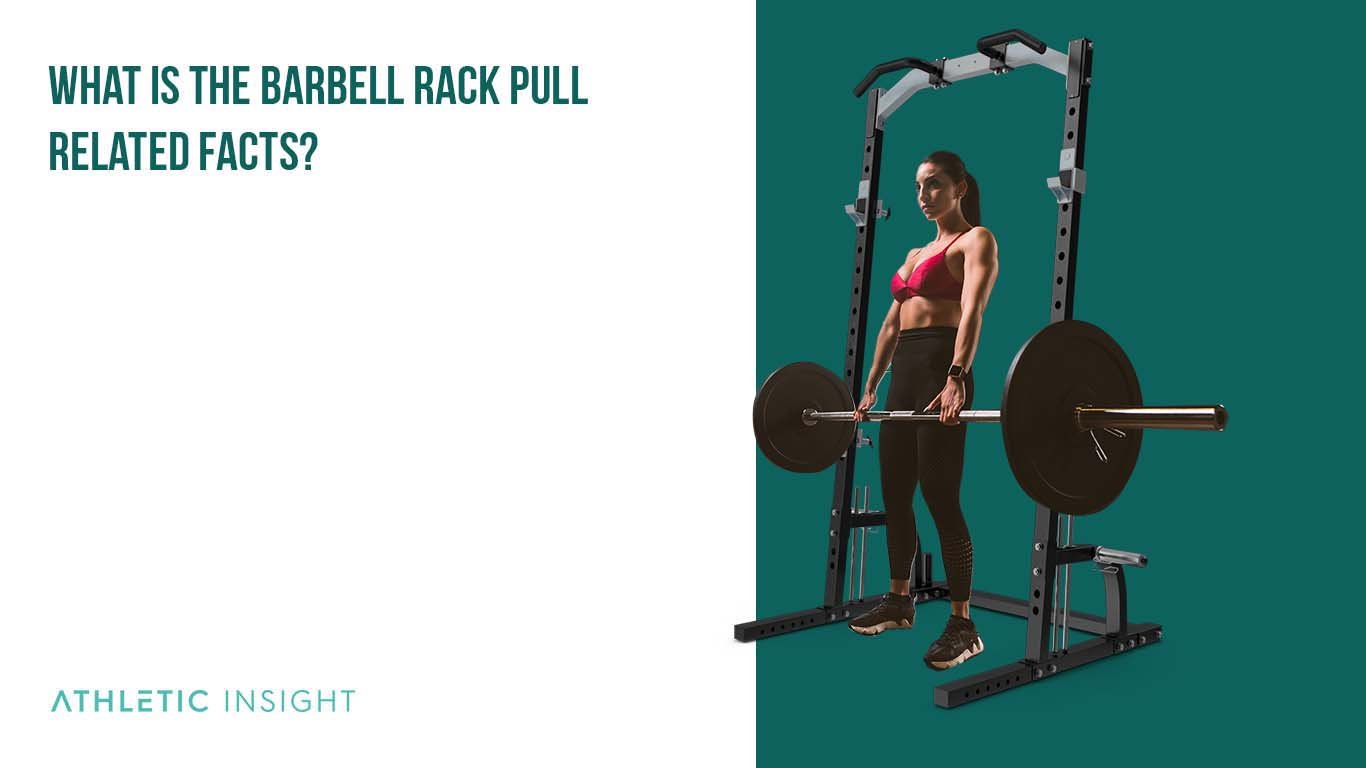A barbell rack pull is a compound weightlifting exercise that develops the glutes, hamstrings, erector spinae, lats, traps, quadriceps, forearms, and core strength. The barbell rack pull also provides a foundation for building muscle and improving muscle definition throughout the body.
The barbell rack pull works well to get beginners into deadlifting safely while offering many benefits such as increased pulling strength, decreased lumbar stress, trapezius and back development, and grip strength. To develop a master barbell rack pull, utilize good form (explained below).
There are four different ways to do rack pulls, these include the reverse band rack pull, rack pulls with accommodating resistance, fat bar rack pulls, and isometric rack pulls. While these are mainly for Olympic deadlift weightlifters, and Strongmen competitors, the rack pull is beneficial for all athletes.
A barbell rack pull allows for handling more weight than a standard deadlift. However, do not sacrifice proper technique by adding too much weight. With good form, barbell rack pull injuries are unlikely, but they do happen.
There are essential barbell rack pull techniques necessary to avoid common mistakes that may lead to injury, such as not keeping the back straight. Common injuries include muscle tears, tendon injuries, back pain, back injury, biceps injuries, knee injuries, hand injuries, finger injuries, and burst blood vessels.
Good form is the antidote to the aforementioned injuries, especially for the back, arms, and legs. If you implement the barbell rack pull into your routine, not only will your deadlift improve, but your muscles will continuously develop.
How to Perform Barbell Rack Pull with Proper Form?
Using proper form is critical to avoid injury and work the target back muscles. There should be a full range of motion, a powerful leg drive, and a pull with the back to complete the lift. Here is the procedure to perform a proper rack pull.
- Set the barbell on the safety bars in a low position on a power rack.
- You can place your feet under your hips or the bar.
- Under the bar, your feet can be slightly closer together than under your hips.
- Squat and grab the barbell with an overhand or mixed grip shoulder-width apart.
- Drive upward by extending your legs and hips to lift the bar.
- At the top of the lift pull back your shoulders if you are rounded. Otherwise, keep your back straight.
- Finally, do all the steps in reverse to return the barbell to the safety bars by bending your knees and hips.
A proper barbell rack pull has a few key components to assure quality – driving with the legs, not rounding the back, and not leaning back.
What are the Benefits of Barbell Rack Pull?
- Core strength comes from doing barbell rack pulls, and there is no other way to gain muscle throughout the body from any other exercise, except deadlifts.
- A barbell rack pull starts with the legs and works up to the abdomen, glutes, back, and shoulders.
- The arms get a static benefit from the tension of holding the weight.
- The whole body develops strength.
What are the Mistakes for Barbell Rack Pull Form?
The rack pull or barbell row is a great exercise for all weightlifters. However, some Barbell Rack Pull Mistakes render the exercise less effective or cause injury.
- Pushing the Hips Forward: Rounding the back is poor barbell rack pull form. Some weightlifters push the hips forward which rounds the back.
- Too Much Weight: Too much weight often leads to poor barbell rack pull form and injury. Use good form while gradually increasing weight.
- Bend the Knees With Feet Forward: When doing a barbell rack pull, bend the knees first, feet facing forward.
- Poor Posture: Roll your shoulders back and straighten the back with feet shoulder-width apart. Improper posture works the wrong muscles and can lead to injury.
How to Determine Proper Weight for Barbell Rack Pull?
The first step in determining proper barbell hold weight is deciding which kind of benefit you want to gain, more strength or muscle hypertrophy?

Hypertrophy calls for more reps with less weight like a pull-up bar, and strength calls for fewer reps with more weight.
For hypertrophy aim for 6-10 reps over 3-5 sets. For strength gain do 3-5 reps and sets until failure for maximum gain at the half rack or work within a 3-5 set range.
Which Muscles are Involved while Performing Barbell Rack Pull?
Here you can see the muscles are involved while performing the barbell rack pull.
- Hamstrings: Starting a barbell rack pull from a high position does not heavily engage the hamstrings. Start lower to achieve more leg drive and work the hamstrings.
- Quadriceps: Quads are less engaged than other muscles, but just like with the hamstrings, start lower and see more quad development.
- Glutes: Glutes do a lot of the work because barbell rack pulls have a limited range of motion, so the large muscle group pulls harder to compensate for the missing muscles. Developing glutes for lifting is an important part of training. The rack pull barbell medicine regimen requires hard work.
- Lower Back Muscles: Barbell rack pulls target the lower back well, due to the limited range of motion. The hips are not doing a lot of work, so the lower back compensates.
- Trapezius Muscles: The traps benefit greatly from barbell rack pulls because the weight engages the whole back, and the traps work like the anchor at the end.
How to Master Barbell Rack Pull?
To dominate the barbell rack pull, it starts with developing good posture and utilizing the perfect form. Below are the steps to master the movement.
1. Squeeze your glutes and push your hips forward
Squeezing the glutes engages the muscles to help with the pull. The move naturally pushes the hips forward, but be careful about too much forward hip movement as it engages the legs more and leads to curving of the back.
Look at how to throw a sandbag over a 44” yoke or barbell on a pull-up rack and see how the hips move forward.
2. Bring the barbell up against your body
The practice comes from the barbell medicine 12-week rack pull program that teaches how to engage the correct muscles by keeping the barbell close to the body.
3. Stand tall again
Practice kipping pull-ups on a cap barbell power rack exercise stand to build the back strength to maintain a straight back through a barbell rack pull.
4. Keeping your weight in front of your body
If your back arches backward, the lower back vertebrae get compressed and easily injured.
5. Return the barbell to the rack
Set the barbell down slowly without dropping the bar to work the muscles until the end. A barbell rack pull alternative that will help with this is to do an isometric pull by placing the barbell under the rack and pulling up.
6. Repeat for the desired number of repetitions
For strength or hypertrophy, do the applicable reps and sets.
What is the Barbell Rack Pull Variations?
Variations of the barbell rack pull are completed using varying rack heights, bands, and only having weight on one side. Variations offer beginner and advanced lifters of the barbell squat rack a way to improve. This is through the ability to tax the muscles in different ways and isolate the muscles further.
Beginners can start with a higher rack and move down after developing enough strength and endurance. The beginner should work on the proper form by doing an unweighted rack pull or utilizing a band. Once you add weight, concentrate on using the proper form learned without weights.
More advanced lifters can use a lower rack height. A lower height provides a better leg drive, but maintaining proper form becomes more challenging. Finally, the most difficult variation is having weight on only a single side of the barbell which will isolate different sides of the body and improve core strength.
What is the Necessary Equipment for Barbell Rack Pull?
The barbell rack pull is an exercise that many people perform to increase the maximum weight that they can lift for a deadlift. The rack pull is meant to help with the lockout position of the deadlift movement. For those that alternatively struggle with getting the bar off of the ground, it is suggested to practice deadlifting on a platform that allows for the bar to be lower than normal, in position to your body.

- Rack: The rack is the largest piece of equipment to hold the barbell at rest. If you are installing a rack at home shop carefully for a rack that can handle punishment from a weighted barbell getting dropped on the safety bars. The weight also slams into the safety bars at the end of the exercise motion.
- Barbell: The barbell is the weighted bar for the hands to grip. If you purchase a barbell, carefully consider the build quality and texture. Doing barbell rack pulls means your hands will grip the bar with incredible strength and tension. The barbell should be comfortable and of high quality.
- Matching Barbell Weights: Get the matching type of weight that fits the barbell. Different types of weights can have different hole sizes. Barbells also come in different sizes, so make sure to get a matching set. Take into account that doing barbell rack pulls over a long period means you will need to add weight to compensate for improved strength. Get weights and a barbell that allows for all different types of weights while stacking plates.
- Barbell Clips: These keep the weights from sliding off the barbell. Barbell clips are a tiny piece of equipment compared to other things found in a gym, but they are critical. Without barbell clips, the weights can slide off the bar and break toes, feet, and even a leg. Always use barbell clips!
- Optional Wrist Straps: Straps help people with grips that need assistance to hold the barbell safely. However, a good barbell rack pull technique demands good enough grip strength to do the exercise properly. Wrist straps are an important tool for people who need them but move toward developing enough grip strength to hold the bar as soon as possible. Barbell medicine rack pull starting weight depends on the weight and experience of the lifter.
What is the Barbell Rack Pull Related Facts?

- Improved Grip Strength: Barbell rack pulls often improve the grip more than dedicated grip exercises because of the weight overload factor and the strain involved. In addition, the grip does not relax during a barbell rack pull. The constant strain of holding the bar improves hand strength, along with everything else. If you need improved grip strength, invest time in rack pulls and see the rest of the body also get stronger.
- Isometric Wrist Gains: Isometric is a static workout that involves strain. Imagine standing in a doorway and pushing on each side to the point of exhaustion. During the barbell rack pull, the wrists lock in one position with little movement, while controlling the barbell, to the point of failure due to fatigue, which results in strength gains.
- Isometric Forearm Gains: Just like the hands and wrist, the forearm muscles lock and the strain of holding the barbell causes the muscles to burn. Muscles react to this kind of stress by getting bigger and stronger. Even though the forearms do not expand and contract, the strain forces them to adapt by getting more capable.
- Isometric Bicep Gains: The strain of holding the barbell moves up the arm, the hands lead to the wrists, which lead to the forearms, and the forearms connect to the elbow and bicep. The bicep gets a different workout than those that lead to more size from doing isolation exercises like curls. However, the muscle tension felt during a rack pull makes the bicep stronger from the isometric tension.
- Isometric Tricep Gains: The triceps work a bit differently than the biceps, although they work together to control the upper arm. The bicep connects to the pectoral muscles, while the tricep connects to the shoulder. The barbell rack pull causes the entire back to strain, so the stress put on the tricep is vital to help control the back. In addition, the tricep controls arm extension, and the weight of the barbell constantly tries to make the arm extend more and puts a huge isometric strain on the triceps. The triceps react by gaining great strength and power.
- Isometric Trapezius Gains: The trapezius muscles cover roughly one-third of the back. These muscles form a large group. Situated on both sides of the spine and spanning from mid-back to the back of the neck, the traps create important power. When barbell rack pull engages all of the back muscles, the final pull to maintain control rests with the trapezius muscles because they go above the shoulders and up to the neck. Without these muscles having the isometric strength to maintain the lift, the lower back muscles would have nothing to transfer the power to, and the shoulders and lats would fall apart. Strong trapezius muscles hold the back together.
Does Barbell Rack Pull affect the Hormones?
The barbell rack pull has the same effect on the hormones as doing exercise in general. Growth Hormone, Testosterone, Insulin, Glucagon, and Cortisol levels all improve.
Hormones
The pituitary gland produces growth hormone which plays a key role in building muscle while burning fat. The process of ridding the body of excess fat in favor of more muscle also retards aging. Growth hormone, testosterone, and insulin all work together to build muscle.
The pituitary gland is a small oval-shaped endocrine gland found at the base of the vertebrate brain and consists of an anterior and posterior lobe. The pituitary controls other endocrine glands and affects growth, metabolism, and maturation.
Growth hormone is vital to support immune function and fights arteriosclerosis. Numerous conditions caused by aging also improve. Just like testosterone, growth hormone secretions decline as we age.
Good sleep is essential because the pituitary gland secretes growth hormones in the early hours of deep sleep. Exercise positively affects the process.
Testosterone
Testosterone is a vital hormone for men and plays a less important role in women’s biology. This hormone is essential to build muscles and burn fat and declines with age along with growth hormone.
Testosterone is a finicky hormone that fluctuates in production throughout a person’s life. Production can drop due to inactivity, and then exercise causes production to increase again. Over-exercise does not overproduce testosterone.
There is a limit to testosterone production, which is why people usually only need to work out for an hour. Focus more on healthy lifestyle habits along with exercise. Avoiding emotional stress is a part of a healthy lifestyle. Eat healthy food and get rest and sleep.
The testicles produce testosterone in men, and so this hormone is also the most important male sex hormone.
Insulin
The pancreas secretes insulin to transport glucose (blood sugar), extracted during digestion, to provide cells with energy.
Insulin also supports anabolic actions in tissues by delivering amino acids. The role insulin plays in managing sugar in the body means that too much insulin leads to weight gain and, potentially, obesity.
Digestive enzymes and some hormones come from the pancreas, and anybody can be insulin resistant or sensitive. Each person’s reaction varies based on several factors:
- Excessive sugar intake
- Lack of exercise
- Obesity
- Emotional stress
- Insufficient dietary fat
- Genetic predisposition
Current conditions, concerns, and circumstances have given rise to medical problems associated with insulin resistance.
Insulin resistance means low blood sugar (hypoglycemia) because eating carbohydrates in excess does not allow insulin levels to decrease. Insulin constantly bombards cells, so the cells develop a resistance that triggers increased insulin production to transport glucose to cells. Not enough sugar reaches cells to get turned into energy as a result.
Over time too much insulin and glucose in the bloodstream causes serious health problems. Not enough sugar gets delivered to cells to create energy which eventually leads to fat storage problems as well.
Part of the damage also means weakened arterial walls which leads to cardiovascular disease and adult-onset diabetes. When some otherwise healthy bodybuilders inject insulin, the same problems occur.
Glucagon
The pancreas also produces glucagon which does the opposite job compared to insulin. Insulin converts blood sugar to glycogen for cells to use, whereas glucagon converts glycogen to blood sugar. The body stores unused glycogen in muscle tissues and the liver as an energy reservoir that glucagon taps when needed.
In early studies of the pancreas, scientists detected an additional substance at work in the glycemic process but were unable to identify the specific cause.
By the 1970s technology caught up and developed the ability to test hormone levels, and glucagon came to be fully understood.
That understanding led to the comprehension of the relationship between insulin and glucagon. Essentially, insulin stores fat, and glucagon uses stored fat to create energy when the body needs a boost.
There are many problems with the modern diet that cause the insulin glucagon process to make the body gain weight uncontrollably. With a proper diet, the body should gain energy from food, store a bit of fat, and tap the fat for energy during exercise.
Currently, the crucial last step glucagon provides is missing for millions of people in the world.
Signs of a broken link in the chain include loss of muscle, chaotic blood sugar fluctuations, appetite cravings, loss of energy, and mood swings usually accompany an imbalance between fat storage or glucagon tapping fat reserves, and adipose development.
Cortisol
Cortisol is the stress hormone and affects the body in powerful ways. Unlike growth hormone and testosterone, cortisol does not have an anabolic (muscle building) effect associated with long life, feeling good, immunity, and energy plus fat burning.
Cortisol is a catabolic (destructive digestion) hormone associated with stress. Under constant stress, the adrenal cortex pumps out cortisol. The catabolic effect means cortisol destroys muscle tissue and increases fat storage.
The adrenal gland is responsible for secreting a variety of steroidal hormones. Classified as endocrine glands, they sit above each kidney.
Anything that causes too much stress elevates cortisol including over-training, losing sleep, poor nutrition and a stressful lifestyle.
As the cycle persists, the catabolic effects of cortisol negate the positive, anabolic effects of growth hormone and testosterone.
Going to the gym helps, but does not ward off the negative effects of cortisol alone. The fight against cortisol calls for a lifestyle change where a healthy diet, exercise, good sleep, and stress avoidance work together to promote anabolic growth instead of catabolic destruction.
Does Barbell Rack Pull Increase Testosterone?
Yes, the barbell rack pull triggers testosterone production in men, the hormone responsible for creating masculine features and improved libido. Strenuous exercise triggers testosterone production in combination with a good diet, low stress, and adequate sleep.
Does Barbell Rack Pull affect the Mood?
Yes, Glucagon levels improve, which reduces sugar cravings associated with mood swings due to a blood sugar imbalance.
Is Barbell Rack Pull a Military Movement?
The deadlift has a strong military history and is similar to a barbell rack pull. However, in the modern military weight gyms are common, and soldiers do many of the same exercises as civilians.
Is Barbell Rack Pull Dangerous?
No, as long as the lifter observes basic safety guidelines. The barbell rack pull helps beginners learn to deadlift safely and allows for weight overloading to build more strength.
Is Barbell Rack Pull Push or Pull?
The weightlifter pulls the barbell the entire time and never uses a push.
Is Barbell Rack Pull Essential?
Yes, especially for strength trainers, but any kind of athlete can build core strength with the barbell rack pull.
Is Barbell Rack Pull an Olympic Lift?
No, the deadlift is in the Olympics, but the barbell rack pull can integrate into deadlift training.



